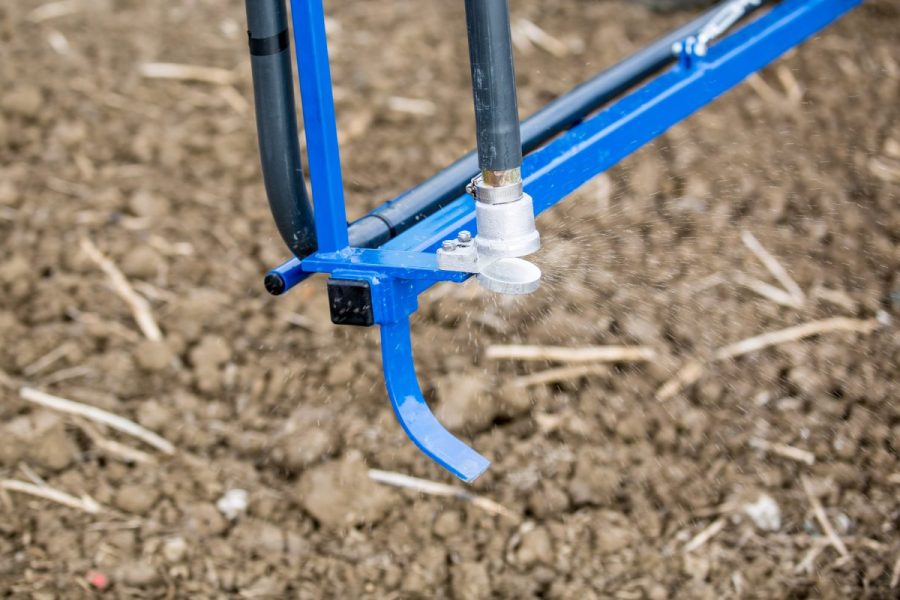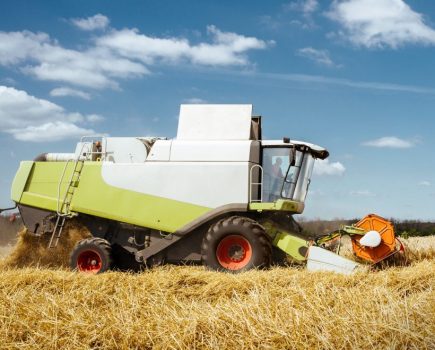With more than 60 years of efficacy under its belt, Avadex (tri-allate) remains a key component in crop protection strategies. But as the application technology evolves, are growers still following best practice? CPM finds out more.
“It’s so important to use Avadex as a foundation product alongside other residuals to get best efficacy on target weeds.” HANK KING
By Charlotte Cunningham
In the battle against grassweeds, few products have stood the test of time quite like Avadex. First introduced more than 60 years ago, the pre-emergence herbicide – based on the active tri-allate – still holds a central role in integrated weed control strategies.
“Tri-allate is one of the few molecules out there with no known resistance in the UK,” explains Hank King, country manager for Gowan. “It continues to give robust control of blackgrass, ryegrass, bromes, wild oats – essentially the whole grassweed complex – and it does so consistently, year in, year out.”
It’s this consistency that’s perhaps Avadex’s defining trait, he adds. “What’s remarkable is that the additional benefit Avadex brings – above your base programme – is stable regardless of whether your base residual is having a good or bad year. That’s huge value.”
That reliability, he stresses, comes with responsibility. “We want this product to continue to deliver outstanding efficacy for users and that means using it correctly now and in the future. Best practice isn’t just about getting it applied – it’s about timing, seedbed preparation, applicator accuracy, environmental stewardship and operator training.”
For Hank, timing is the first principle. “Avadex is strictly a pre-emergence treatment, and the greatest efficacy is achieved when applied within 24-48 hours of drilling. That’s when you have the best chance of the product being in the right place for weed germination at the right time and therefore maximising efficacy.
“If the top 5-8cm of soil are absolutely bone dry, nothing’s germinating – so Avadex won’t be doing what it does best. In that case, you should delay slightly until conditions are conducive for weed germination. But be mindful that autumn weather can turn quickly, so be careful in this scenario.”
Seedbed quality matters too. “Clods can harbour weed seeds which are then not in contact with the herbicide. Rolling before application, if possible, is best practice and gives Avadex the best chance of delivering its greatest efficacy. It’s not essential, but it’s very much best practice.”
Hank is equally firm on applicator standards. “Liquid sprayers are tested annually without fail but granular applicators don’t always get the same attention. Annual servicing including calibration and pattern testing are critical, but regular machinery checks throughout the season are equally vital.
“As an example, deflector plates can be bumped in transport or field work, and that will distort your spread pattern. Always test for even distribution before you start.”
Operator training is another area which he believes shouldn’t be compromised. “Anyone applying Avadex Excel must have a PA4G certificate. If the applicator is mounted on the back of the drill then this includes drill operators too.”
With the liquid formulation (Avadex Factor), the principles are slightly different. “Standard spray practice still applies – correct boom height, buffer zones, recommended water volumes and sensible forward speeds all contribute to consistent coverage. Avadex Factor will work in drier conditions, but it performs best where there’s some soil moisture. Another important point is to avoid applying it at the peak heat of the day. If you can apply in cooling conditions, for example in late afternoon or early evening, then you tend to get better results.”
Looking at the kit involved when it comes to applying Avadex, there are a number of options available from manufacturers including Stocks Ag, Opico, Techneat and Horstine. Joe Allen of Horstine says selecting the right applicator for the individual farm, its set up and its requirements, are key to getting the best from Avadex.
“When Avadex is part of the resistance-busting stack, the two non-negotiables are timing and uniformity,” he says. “That means utilising an applicator that can keep pace with drilling and deliver a consistent 15kg/ha across every run and headland shape.”
He believes Horstine’s line-up reflects that. “The TM Air is a compact drill- or roll-mounted unit, popular with smaller farms or where growers want granules going on at the point of drilling.
“The TMA4, available at 12m, offers an affordable standalone option, either linkage-mounted or trailer-towed behind an ATV. At the top end sits the Cascade, aimed at contractors with big areas – a 1500-litre hopper, wide booms and four independently controlled sections make it well-suited to long runs and awkward headlands.”
One benefit is that all the machines are pneumatic, he adds. “A central hopper meters granules into air streams that carry them to fishtail outlets along the boom. Those outlets are set up to create a double overlap – just like a sprayer – so each pass smooths out any variation.”
Crucially, each outlet has its own metering rotor. “We don’t meter once and split,” says Joe. “Every point is identical so there’s no risk of one end of the boom under-applying while another is over-applying. That’s something Gowan is very keen on – it protects crop safety as well as weed control.”
Modern control systems now mirror sprayers too, he points out. “Avadex is a fixed-rate job at 15kg/ha, so the challenge is holding that rate regardless of speed. Our applicators take a signal from the tractor or a GPS sensor and adjust automatically. Cascade goes a step further: as you turn on headlands, the ECU varies delivery across the boom sections to account for the inner end slowing and the outer end speeding up. That’s how you keep coverage consistent in real-world field shapes.”
Calibration has been kept intentionally simple, too. “Prompt the rotors, collect and weigh, adjust if required. Users find the machines extremely accurate – it means you can order product with confidence, knowing hectares covered will tally with tonnes applied.”
With best practice in mind, maintenance is where Joe urges growers to not cut corners. “Granules are abrasive, so the metering unit is the main wear point. We use hardened parts and stainless-faced washers, but tolerances should be checked and refreshed pre-season.
“Pipework requires a visual check too – splits at folds or joins will show up as granules leaking where they shouldn’t. A quick pre-season once-over, plus annual NSTS testing, is the best way to keep performance good.
“Granular chemistry is a rarer sight on farms than it used to be, but where Avadex earns its keep, the applicator has to be simple, accurate and fast. Individual rotors, pneumatic delivery and intelligent control are the three pillars we build around. They target the two things that matter most: a consistent 15kg/ha and the ability to apply it exactly when the window opens.”
Jonathan Tunmore, contractor in East Suffolk, is an advocate for how this best practice theory plays out in reality. “By background, I was a farm manager, then moved into pest control, but I could see Avadex starting to take off again about 2011,” he recalls.
“Blackgrass was a huge problem; my wife is an agronomist and we both felt demand was about to go mad, so we built our own application machines to start with then sold those and invested in bigger kit. Last year we covered around 2500ha and I’d expect it to be similar again this year – sometimes it’s closer to 3000ha, depending on the season.”
Jonathan now runs a 24m self-propelled and a 36m trailed Rauch unit, both with generous hopper capacities. “That’s what often lets machines down – small hoppers. With ours we can do 250-300ha in one load which makes a huge difference when you’re trying to cover ground fast. Both machines are on wide tyres – 750s on the self-propelled, 710s on the trailed – so we can tread lightly and keep travelling when soils are softer.”
With ensuring best practice always the goal, Jonathan says the machines’ design gives him confidence. “Each outlet has its own fluted metering roller, so distribution is spot on. They’re straight-piped with three fans driving air down large-bore tubes, so granules get to the outlets very quickly. That produces a really clean, reliable pattern. Other machines that split product part-way down the pipe just can’t match it.”
He’s also developed his own routines for filling and monitoring. “I cut bags a particular way so nothing’s left inside; we work in lots of 10 and keep empty bags nested inside one so you don’t lose count. Always fill the hopper level so you can see the flow, and constantly check product against area covered – with big hoppers you really have to keep an eye on it.”
He’s equally clear on timing. “Avadex prefers going onto a moist seedbed. If you get heavy rain straight on top, it doesn’t work quite as well but when it’s applied in the right slot, it’s very consistent. The trouble is, drilling dates are narrowing – when I first started we’d be applying from about 10 September, but now it’s more like the 20th or 25th, which is 10-15 days lost.”
Although new chemistry to battle blackgrass is starting to appear, Jonathan still sees Avadex as unique. “There’s competition on the borders now with new technology, but Avadex is well understood and dependable. If you know your machine, your soils and your timing, it still earns its keep.”
For him, the key is familiarity. “When it’s one man, one machine, you really get to know it. You can tell immediately if something’s not right. That’s how you keep accuracy – and keep Avadex delivering.”
And it’s this accuracy that means six decades on, tri-allate has earned its place not through novelty. but through reliability. However, that reliability depends on everyone in the chain – from manufacturer to applicator to contractor – holding up their end of the stewardship bargain. “It’s so important to use Avadex as a foundation product alongside other residuals to get best efficacy on target weeds,” concludes Hank.
“This means utilising products with different modes of action in the stack or sequence actives to protect against resistance, and combine with cultural controls like delayed drilling, competitive varieties and stale seedbeds. That’s how you keep the chemistry working and get the greatest efficacy.”
This article was taken from the latest issue of CPM. Read the article in full here.
For more articles like this, subscribe here.
Sign up for Crop Production Magazine’s FREE e-newsletter here.




